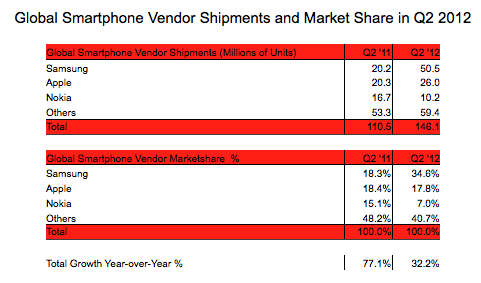Now that all the big handset makers have put in their quarterly sales figures, Strategy Analytics has done the number crunching for an overall picture of what happened in the mobile market. The upshot: just as many predicted, mobile as a whole — facing wider economic slowdown and “shifting consumer tastes” — remained largely flat, growing by just 1%. But smartphones, still at a less mature state, are selling much better: collectively, shipments (which equals sales in SA’s book) grew by 32% in the quarter, the analysts said, with Samsung and Apple leading the way with over half the global market between them.
That sounds like a good-news story for smartphones, except when you understand that 32% growth (146.1 million units total in Q2) is actually the slowest the smartphone market has expanded in three years. In comparison, the market grew by 77% in the same quarter a year ago.
Strategy Analytics says that overall mobile handset sales totalled 362 million units, compared to 358 million for the same quarter a year ago.
As it did last quarter, Samsung continued to widen its lead over Nokia in overall sales. Strategy Analytics estimates that Samsung sold 93 million handsets in the last quarter, accounting for just over one-quarter of the total number of handsets sold (Samsung didn’t report unit sales in its Q2 results so SA estimates). Nokia, meanwhile, dropped down to 83.7 million handsets.
What’s interesting is that smartphones really are driving growth (and decline) for these companies now, not just in a strategic but in a bottom-line kind of way: As you can see in the table below, smartphones, and specifically the Android-based Galaxy line, accounted for over half of Samsung’s total mobile sales (50.5 million handsets; 37% of the smartphone market). Analyst Neil Mawston notes that this was the largest number of units ever shipped by a smartphone vendor in a single quarter. “Samsung has been able to deliver hit models in most major price segments,” he notes — a vote in favor of a varied range of products from the larger Galaxy Note to the Galaxy Y, in comparison to Apple’s slimmed-down offering of essentially three models.
On the other hand, Nokia’s 10 million smartphone sales (4 million Windows Phone Lumia devices still being outnumbered by the older Symbian platform) translated to a 7% smartphone share, its lowest share in a decade, Strategy Analytics analyst Neil Shah noted.
Taking out smartphones from the mix, Samsung sold about 43 million handsets to Nokia’s 74 million. Feature phones, with models featuring dual-SIM slots and the Asha line of “smartphone-like” low-end devices, was one brightish spot for Nokia in its quarterly earnings: it grew shipments of these by 2%, although that wasn’t enough to offset continuing declines in smartphones.
Apple’s 26 million iPhone shipments were not exactly thrilling to analysts this week; and in Strategy Analytics’ ranking, it saw its overall share of all smartphone sales shrink as well. That’s something that had already been tracked by Kantar Worldpanel, which noted that over the past three months Android had been outselling iOS in all major markets that it surveys. And Apple itself noted particular softness in traditionally strong markets: European iPhone sales, for example, were “essentially flat” according to CEO Tim Cook.
Apple’s share is now at 17.8% (versus 18.4% in Q2 last year) — no match for Samsung nearly doubling its market share. In fact, Samsung was the only handset maker (again, using Strategy Analytics estimates, not number from Samsung itself) to have outpaced average smartphone market growth this quarter.
The emphasis now, Strategy Analytics notes, is on how well Apple will be able to execute the launch of its next device. Apple has yet to confirm anything about this but in CEO Tim Cook’s comments this week on the earnings call, he acknowledged Apple’s softening sales as possibly related to anticipation around the next device — people are holding off until the newer iPhone model comes out, implying this would turn around with the next launch.
The overall slowdown in phone sales has also meant something else. The threat of smaller players who had been hoping to break into the big time has effectively been neutralized, and those who are big but have been massively challenged more recently (eg RIM and Nokia) will probably find it even harder to turn things around.


[Image: Mike Fleming, Flicker]
